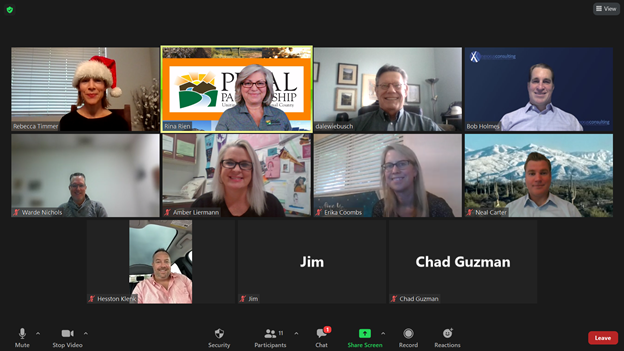Co-Chairs Dale Wiebusch, City of Maricopa and Rebecca Timmer, Wilson & Company kicked off the last meeting of the year for the Government Relations Committee. Guest Speaker Bob Holmes, Nexxus Consulting presented an overview of the Infrastructure Investment and Jobs Act. $550 billion has been appropriated which includes transportation infrastructure, public transit, broadband, airports, ports and waterways, passenger and freight rail, infrastructure safety, and water capital projects. The bill will be paid for through unused Covid relief dollars and multiple other funding sources. There will be no new taxes.
For Arizona, ADOT will have access to funding for major highway and bridge repairs and new construction, which could include I-11, I-10, and SR 347 in Pinal County. Transit agencies such as CART (Central Arizona Regional Transit) are eligible. Amtrak expansion project is envisioned for a connection between Phoenix and Tucson. It’s projected that $100 million will go to Arizona for broadband development. There will be funding available for improvements for Pinal County airports.
He added that western water infrastructure will benefit dramatically from the funding, which includes 150 projects in Arizona to improve efficiency. There is specific funding available for the Indian Water Rights Settlement and for tribal communities and farmers.
Bob reported Inland Ports in Arizona will be fully funded by the bill including San Luis and new and existing Douglas Ports of Entry. Other potential programs of interest include lead pipe removal, Superfund site cleanup, Brownfields program, clean energy school buses, wildfire management and environmental review for major projects.
Ward Nichols asked if there would be any investment in the electrical grid to support expanded electric vehicle programs, as there will be an increased demand on electricity due to home-based charging. There is funding allocated for grid reliability and resiliency per Bob with emphasis on promoting public/private partnerships. Jim Mullin commented about how home charging loads will need to be upgraded with the advent of longer distance battery life.
Ward Nichols expressed concern about recycling and landfill impact of electric vehicle batteries and plans for recycle/reuse. Hesston Klenk indicated the mining industry is already recycling using smelters for a variety of metals.
Hesston Klenk asked how corporate partners can advocate for more dollars funneling to rural communities. Bob recommended that rural communities contact their congressional representatives to advocate for equitable funding.
Dale communicated that this is an opportunity for Pinal Partnership to advocate as a collective voice for the County. Co-Chair Rebecca Timmer noted that a resolution could be recommended to the Pinal Partnership Board for the purposes of advocating for funding.
Bob anticipated formula funds should be allocated to the states by end of year and discretionary grants will follow in the summer of 2022. Here are more details from Bob’s presentation: Presentationhttps://pinalpartnership.com/wp-content/uploads/2021/12/Fast Facts about IIJA Pinal Parntership.pptx
Rebecca suggested a joint meeting with the Transportation and Water Resource Committees in mid-2022 with Bob to provide more specifics on the funding allocations.
Independent Redistricting Commission (IRC) continues to meet to refine the legislative and congressional maps. There are still points of contention between commissioners. Maps should be finalized by December 22, 2021.
FYI – the Legislative Session begins January 10th, 2022.
Rebecca indicated that the next PPGRC Meeting will be January 25th with speaker Mitch Basefsky, Central Arizona Project providing a CAP update.

